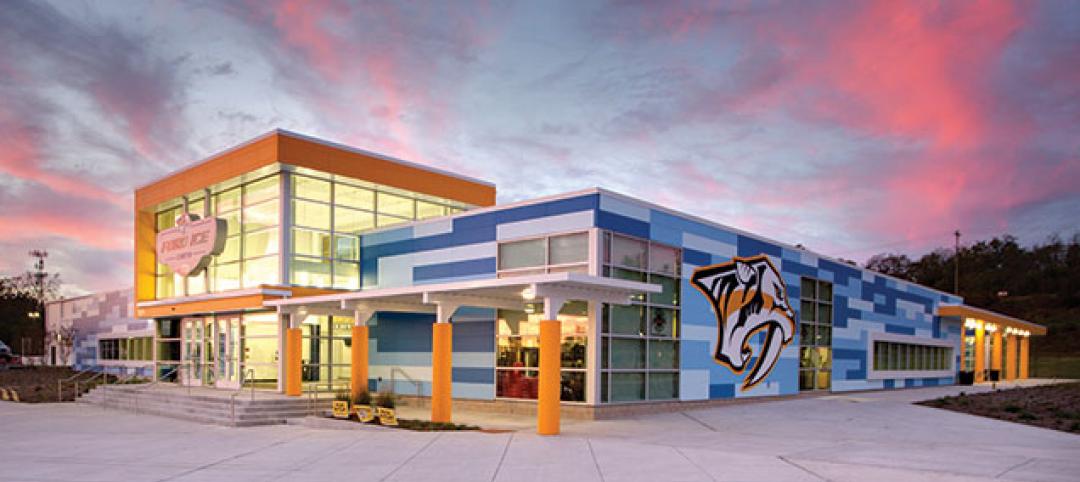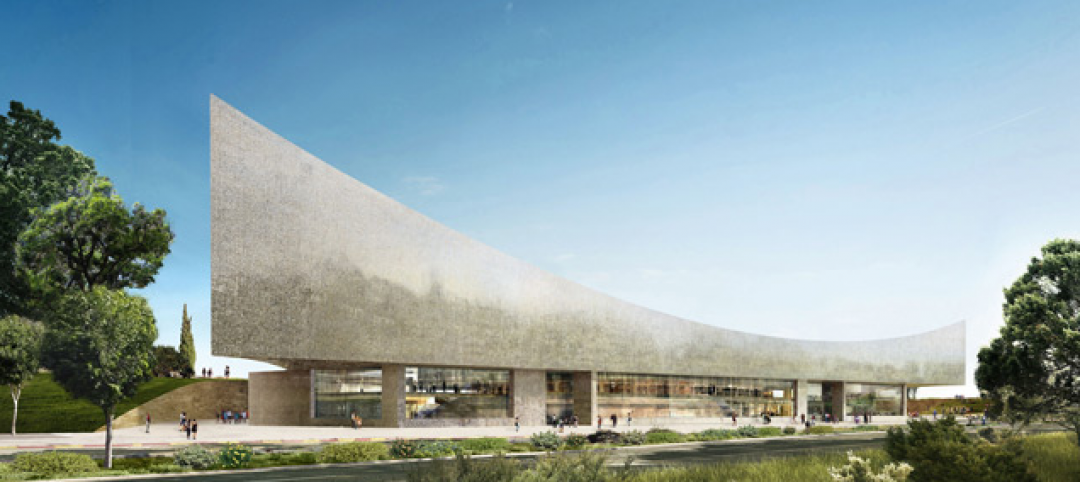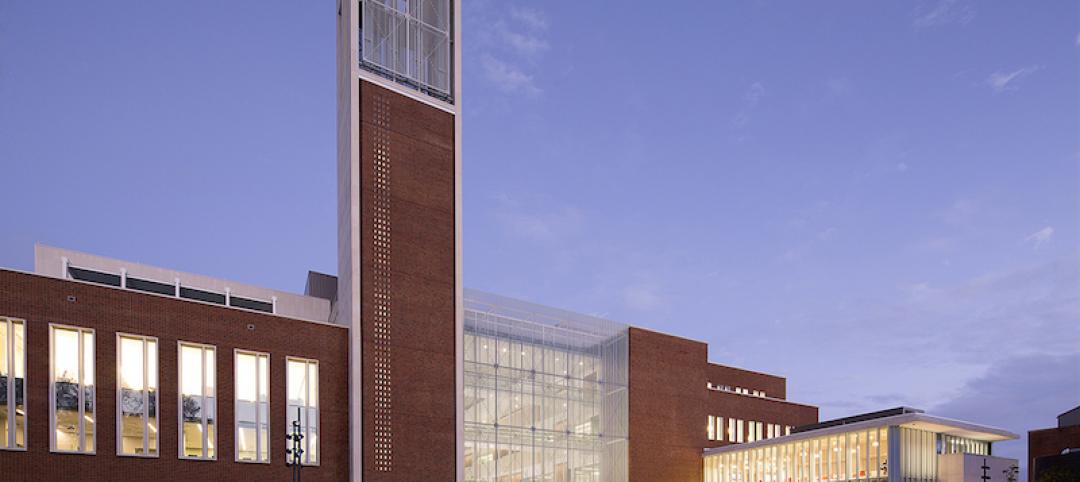The American Institute of Architects (AIA) and the American Library Association (ALA) selected eight recipients to receive the 2017 AIA/ALA Library Building Awards. The AIA and the ALA developed this award program to encourage and recognize excellence in the architectural design of libraries. As the traditional role of libraries evolves, the designs of these community spaces have changed to reflect the needs of the surrounding residence, as represented by the recipients of the AIA/ALA Library Building Awards. Click the project names to view additional information and images.
Boston Public Library, Central Library Renovation; Boston
William Rawn Associates, Architects, Inc.
 Photo: Robert Benson Photography.
Photo: Robert Benson Photography.
The renovation of this 156,000-square-foot civic monument provides immersive and engaging learning experiences for patrons inside as well as pedestrians who pass by. Originally constructed in 1895, this renovation has dramatically transformed a wing of the library from a solid stone bunker to an inviting light-filled space that spills out into a newly defined public plaza. The interior space was carefully reconsidered through the lens of a 21st-century patron to address the needs of all visitors, from pre-readers to adults. To further serve as a hub for education and innovation, the library boasts a range of spaces for both formal and informal convening. A 340-seat auditorium, open space for performances, and a conference center have helped increase public interest and the free flow of ideas. The greatest benefit to patrons, however, is the much more fluid connection between both wings of the library.
Columbus Metropolitan Library – Whitehall; Columbus, Ohio
JBAD
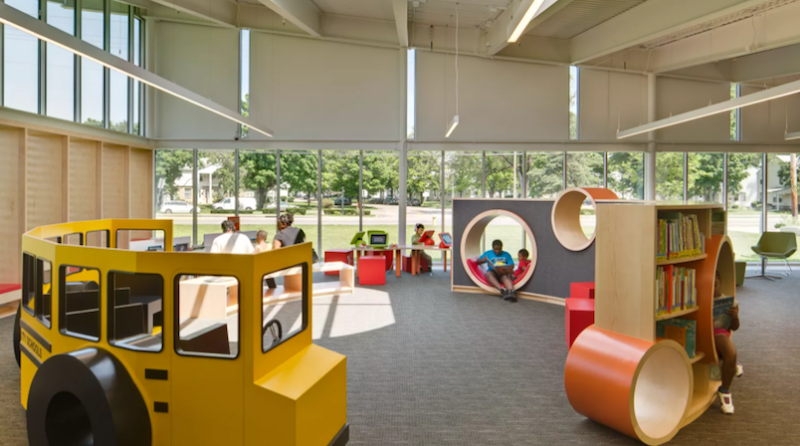 Photo: Brad Feinknopf
Photo: Brad Feinknopf
Surrounded by lawns, meadows, and planting beds, the library’s façades are clad in metal panels complemented by storefront glazing with varying levels of transparency—greater in public areas and less in staff and support areas. The simple configuration, flooded by reading-friendly northern light, provides maximum flexibility for the rapidly changing needs of modern libraries. Having achieved LEED Silver certification, the library’s sustainable strategies can be noted throughout. Interior fins and external louvers on the library’s west-facing glass control heat gain while still providing quality reading light, and advanced HVAC systems in the public areas provide service from only the perimeter, allowing easy accommodation of new technologies and future opportunities. Further adding to the library’s arsenal of teaching tools, a series of LED screens displays the structure’s energy performance in real time.
East Boston Branch Library; Boston
William Rawn Associates, Architects, Inc.
 Photo: RobertBensonPhotography
Photo: RobertBensonPhotography
With its glass façades overlooking the 18-acre park that emerged from the city’s Big Dig project, the new library boasts an airy column-free reading room with dedicated areas for adults, teens, and children. The open plan allows families to visit together and not be corralled into separate rooms, while clear sightlines maximize staffing efficiency. Shelving on casters lends extra flexibility, allowing librarians to curate the collections over time and adapt to the evolving needs of a modern library. Capping the library is an undulating roof that admits ample daylight to fill wood-wrapped common areas. The site was a former brownfield and, beyond its transformation into a civic hub, the library has a number of sustainable features. In addition to high-performance mechanical systems and proximity to mass transit, a stormwater garden greets visitors at the sidewalk, with signage describing its role in promoting the health of Boston Harbor. Overshooting the city’s target of Silver, the new library received LEED Gold certification.
National Library of Latvia; Riga, Latvia
Gunnar Birkerts Architects; Associate Architect: Gelzis-Smits/Arhetips
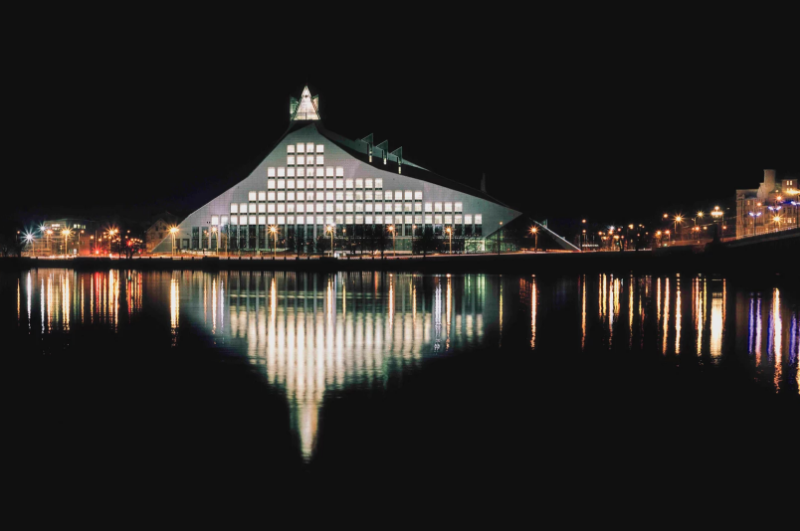 Photo: Indriķis Stūrmanis
Photo: Indriķis Stūrmanis
The new library, at nearly 600,000 square feet is situated at the terminus of a bridge spanning the River Daugava. It was envisioned as a place to store, preserve, and make accessible the country’s cultural heritage. To that end, it is supported by state-of-the-art technology that allows for easy digitization and safe storage. The library’s form dovetails with functionality by accommodating the various collections areas. Presented in vertical arrays in appropriately sized spaces, they all connect to the central stack core. A full wall display of books donated by Latvians as a symbolic gesture soars through the atrium and teases the massive adjacent stack area. The atrium itself, with its central stair, provides connectivity to all the public levels and serves as a unifying element that illustrates the library’s logical organization and circulation.
New York Public Library Stapleton Branch Renovation and Expansion; New York City
Andrew Berman Architect, PLLC
 Photo: Naho Kubota
Photo: Naho Kubota
Expanding from a single-room Carnegie branch library that had served Stapleton, Staten Island, for a century, this project has created a new 12,000-square-foot library that better serves the community. Open, inviting, and accessible, the project stitches together new and old buildings, and provides equal space for tactile and digital learning opportunities. Restored to its original design, the existing Carnegie library now houses the children’s area, while the expansion on the other side of a transparent community room contains teen and adult reading areas and research facilities. The library’s exposed-wood structure provides rhythm and richness, while the glazed façade supplies natural light and invites participation. Additional natural light comes courtesy of multiple framed skylights, and the variegated surfaces of the roof and façade diffuse and deflect sound waves to soften the acoustics of the open plan.
Rosa F. Keller Library and Community Center; New Orleans
Eskew+Dumez+Ripple
 Photo: Timothy Hursley
Photo: Timothy Hursley
Funded entirely through the Federal Emergency Management Agency’s recovery program, the project involved the restoration of a 1917 Arts and Crafts bungalow that serves as a community center and reconstruction of an adjacent 6,300-square-foot library wing. Together, the new library and restored community center provide the neighborhood with an innovative 21st-century facility that offers ample opportunities to engage with technology and alternative educational outreach programs. The project has achieved LEED Silver certification, with all its aspects bearing hallmarks of sensitive community engagement. Key programmatic elements—evident in the catering kitchen and café—reference the importance of culture as the driving force that helps communities recover from disaster. With food and its preparation playing a pivotal role in the lives of so many Louisianans, the adjacency of food and words is the perfect match for a very New Orleans–style approach to sustainability.
University of Oregon Allan Price Science Commons & Research Library Remodel / Expansion; Eugene, Ore.
Opsis Architecture LLP
 Photo: Christian Columbres
Photo: Christian Columbres
Guided by feedback provided by the University of Oregon’s student body, this project included a complete renovation and addition to an existing underground library. Atop an 48,000-square-foot underground library, the project added 4,000 square feet of new space. Occupying a difficult site wedged between two buildings, sub-floor-to-high-ceiling windows illuminate the commons space with natural light. A new entry pavilion supplements a brutalist courtyard that exacerbated the subterranean conditions of the existing library and maximizes available light below. A wood curtainwall sprouts organically in the courtyard, creating a calming forest atmosphere that completes the expression of light and nature. Students and faculty have enjoyed the variety of spaces, with some students remarking that they had forgotten they were underground since the space no longer feels like a basement.
Varina Area Library; Henrico, Va.
BCWH, Associate Architect: Tappe Architects
 Photo: Chris Cunningham Photography
Photo: Chris Cunningham Photography
Firmly rooted in its natural environment, the library’s design was inspired by the community’s vernacular. With a series of pavilions that emerge and cascade down the landscape, the design’s simple palette and forms evoke an assemblage of tobacco barns. Inside, the new library provides countless opportunities for patrons to engage with the collections and the staff. The client and the design team worked hand in hand to develop an intuitive floor plan that maximizes views of the natural setting, further amplified by a back porch–style overlook in the rear of each pavilion. To provide easy access for its nearly 300,000 cardholders, the library’s configuration allows for quick transactions when needed. Following that directive allowed the team to consolidate programming and take a balanced approach to open day-lit spaces and enclosed quiet spaces, and to increase efficiency in the mechanical systems and ductwork runs.
Related Stories
Sponsored | Cladding and Facade Systems | Mar 24, 2015
Designers turn a struggling mall into a hub of learning and recreation
Architects help Nashville government transform a struggling mall into a new community space.
Retail Centers | Mar 10, 2015
Retrofit projects give dying malls new purpose
Approximately one-third of the country’s 1,200 enclosed malls are dead or dying. The good news is that a sizable portion of that building stock is being repurposed.
| Jan 2, 2015
Construction put in place enjoyed healthy gains in 2014
Construction consultant FMI foresees—with some caveats—continuing growth in the office, lodging, and manufacturing sectors. But funding uncertainties raise red flags in education and healthcare.
| Dec 29, 2014
Spherical reflectors help spread daylight throughout a college library in Portland, Ore. [BD+C's 2014 Great Solutions Report]
The 40,000-sf library is equipped with four “cones of light,” spherical reflectors made from extruded aluminum that distribute daylight from the library’s third floor to illuminate the second. The innovation was named a 2014 Great Solution by the editors of Building Design+Construction.
| Dec 28, 2014
AIA course: Enhancing interior comfort while improving overall building efficacy
Providing more comfortable conditions to building occupants has become a top priority in today’s interior designs. This course is worth 1.0 AIA LU/HSW.
| Nov 10, 2014
Herzog & De Meuron unveils plan for National Library of Israel
The library’s new home will be a completely new building in Jerusalem, and will combine the functions of a central research center, a venue for indoor and outdoor cultural and educational activities, and a place for digital experience.
| Oct 16, 2014
Report: How to keep public libraries relevant in a digital age
Public libraries will avoid being relegated to the scrap heap of history in a digital age as long as they continue to serve as platforms for learning, creativity, and innovation that strengthen their communities, according to a new Aspen Institute report.
| Oct 16, 2014
Perkins+Will white paper examines alternatives to flame retardant building materials
The white paper includes a list of 193 flame retardants, including 29 discovered in building and household products, 50 found in the indoor environment, and 33 in human blood, milk, and tissues.
| Oct 15, 2014
Harvard launches ‘design-centric’ center for green buildings and cities
The impetus behind Harvard's Center for Green Buildings and Cities is what the design school’s dean, Mohsen Mostafavi, describes as a “rapidly urbanizing global economy,” in which cities are building new structures “on a massive scale.”
| Oct 12, 2014
AIA 2030 commitment: Five years on, are we any closer to net-zero?
This year marks the fifth anniversary of the American Institute of Architects’ effort to have architecture firms voluntarily pledge net-zero energy design for all their buildings by 2030.



